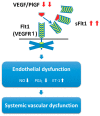Preeclampsia: Maternal Systemic Vascular Disorder Caused by Generalized Endothelial Dysfunction Due to Placental Antiangiogenic Factors
- PMID: 31480243
- PMCID: PMC6747625
- DOI: 10.3390/ijms20174246
Preeclampsia: Maternal Systemic Vascular Disorder Caused by Generalized Endothelial Dysfunction Due to Placental Antiangiogenic Factors
Abstract
Preeclampsia, a systemic vascular disorder characterized by new-onset hypertension and proteinuria after 20 weeks of gestation, is the leading cause of maternal and perinatal morbidity and mortality. Maternal endothelial dysfunction caused by placental factors has long been accepted with respect to the pathophysiology of preeclampsia. Over the past decade, increased production of placental antiangiogenic factors has been identified as a placental factor leading to maternal endothelial dysfunction and systemic vascular dysfunction. This review summarizes the recent advances in understanding the molecular mechanisms of endothelial dysfunction caused by placental antiangiogenic factors, and the novel clinical strategies based on these discoveries.
Keywords: angiogenic imbalance; arterial stiffness; endothelial dysfunction; placental growth factor; preeclampsia; soluble fms-like tyrosine kinase 1; systemic vascular dysfunction; vascular endothelial growth factor.
Conflict of interest statement
The authors declare no conflict of interest.
Figures


References
-
- Hepner D.L., Wilkins-Haug L., Marks P.W. Hematologic disease. In: Cunningham F.G., Leveno K.J., editors. Anesthetic and Obstetric Management of High-Risk Pregnancy. Springer; New York, NY, USA: 2004. pp. 309–332.
Publication types
MeSH terms
Substances
LinkOut - more resources
Full Text Sources
Miscellaneous

